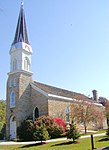Oheyawahi-Pilot Knob
Dakota peopleNational Register of Historic Places in Dakota County, MinnesotaNative American history of MinnesotaNatural features on the National Register of Historic Places in MinnesotaTourist attractions in Minnesota

Oheyawahi-Pilot Knob (Dakota: Oȟéyawahe, lit. 'a sacred place much visited; the place where people go for burials') is a scenic overlook, and a Native American gathering place and burial ground in Mendota Heights, Minnesota, United States. The overlook provides views of the confluence of the Minnesota and Mississippi Rivers, Fort Snelling, and the Minneapolis and St. Paul skylines. It was the site of the 1851 Treaty of Mendota between the United States federal government and the Dakota people of Minnesota, who consider the site sacred. In 2017, Oheyawahi-Pilot Knob was listed on the National Register of Historic Places.
Excerpt from the Wikipedia article Oheyawahi-Pilot Knob (License: CC BY-SA 3.0, Authors, Images).Oheyawahi-Pilot Knob
Pilot Knob Road,
Geographical coordinates (GPS) Address Nearby Places Show on map
Geographical coordinates (GPS)
| Latitude | Longitude |
|---|---|
| N 44.880380555556 ° | E -93.167277777778 ° |
Address
Pilot Knob Road 2038
55120
Minnesota, United States
Open on Google Maps








